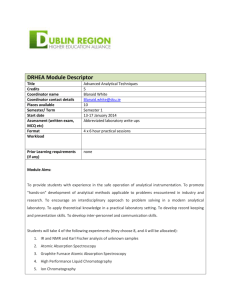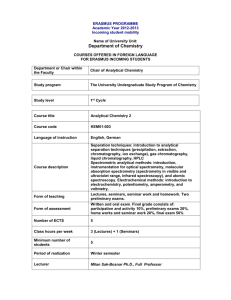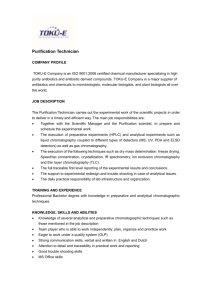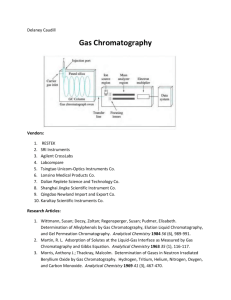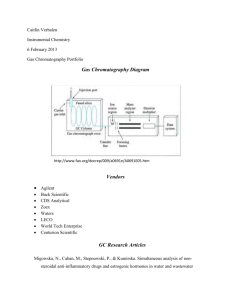Chem 323 Syllabus - KFUPM Open Courseware
advertisement
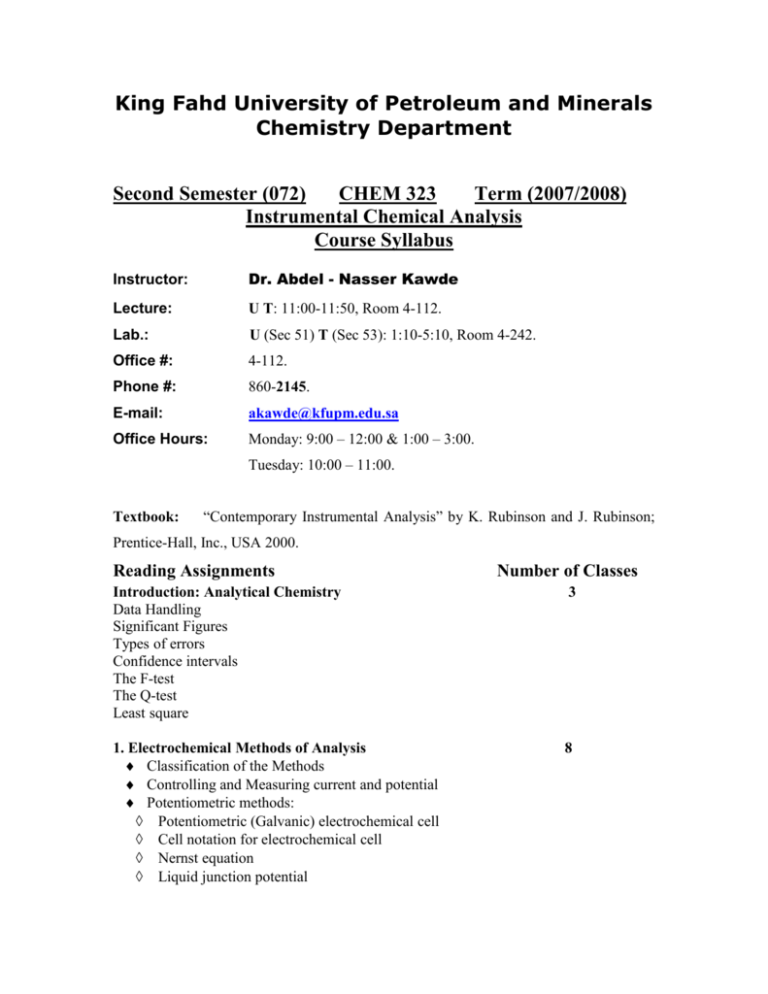
King Fahd University of Petroleum and Minerals Chemistry Department Second Semester (072) CHEM 323 Term (2007/2008) Instrumental Chemical Analysis Course Syllabus Instructor: Dr. Abdel - Nasser Kawde Lecture: U T: 11:00-11:50, Room 4-112. Lab.: U (Sec 51) T (Sec 53): 1:10-5:10, Room 4-242. Office #: 4-112. Phone #: 860-2145. E-mail: akawde@kfupm.edu.sa Office Hours: Monday: 9:00 – 12:00 & 1:00 – 3:00. Tuesday: 10:00 – 11:00. Textbook: “Contemporary Instrumental Analysis” by K. Rubinson and J. Rubinson; Prentice-Hall, Inc., USA 2000. Reading Assignments Number of Classes Introduction: Analytical Chemistry Data Handling Significant Figures Types of errors Confidence intervals The F-test The Q-test Least square 3 1. Electrochemical Methods of Analysis Classification of the Methods Controlling and Measuring current and potential Potentiometric methods: Potentiometric (Galvanic) electrochemical cell Cell notation for electrochemical cell Nernst equation Liquid junction potential 8 Reference electrodes Quantitative applications Voltammetry Voltammetric (Electrolytic) electrochemical cell Voltammetric measurements Current in voltammetry Voltammetric techniques: polarography, stripping analysis, amperometry Analytical applications 2. Molecular Spectrophotometry Properties of light Electromagnetic radiation and electromagnetic spectrum Absorption of light Beer’s law Limitation of Beer’s law Absorption of light by molecules Instrumentation: Spectrophotometer Applications: individual species and mixtures Spectrophotometric titration 5 3. Atomic Spectroscopy Atomic Spectra: emission and absorption spectra Atomic spectroscopy based upon flame atomization Flame atomizers Properties of flames Types of flames used in atomic spectroscopy The effects of flame temperature Absorption and emission spectra in flames Ionization in flames 6 Flame atomic absorption spectroscopy Line width: Line broadening Spectral line sources: hollow-cathode lamps, electrodeless discharge lamps Source modulation Instruments for atomic absorption spectroscopy: photometers and spectrophotometers Interferences: Spectral, chemical, ionization interferences Applications in quantitative analysis Flame emission spectroscopy Instruments Interferences Applications Atomic spectroscopy with electrothermal atomizers Atomic emission methods based on plasma sources: Inductively coupled plasma Direct current argon plasma 4. General Introduction to Separation and Chromatography Definition of Chromatography The First Chromatography Experiment Nomenclature of Chromatographic Separation Descriptions of Experimental Chromatogram Parameters of Chromatography Quantization in Chromatography Explaining Chromatographic Separations Zone Broadening: The van Deemter Equation Improving Separations Asymmetrical Peaks Multidimensional Techniques 4 5. Gas Chromatography and Supercritical Fluid Chromatography 4 Comparison between Gas, Supercritical Fluid and Liquid Chromatography The Nomenclature of Gas Chromatography Samples Analyzed by GC Sample Introduction, Splitters, and Columns Detectors for Gas Chromatography Supercritical Fluid Chromatography Attendance Students are required to abide by KFUPM regulations regarding attendance (Page-38 of the undergraduate bulletin 2006-2009). Regular attendance by students in the course is required. Unexpected absences are not permitted According to University regulations, a DN grade will be immediately reported to the Deanship of Admission and Regulations, as soon as a student becomes eligible (when unexcused absences exceeds one-fifth (6/30) of the total class hours of the course) without waiting until the end of the semester. Reporting of DN grade will be strictly enforced. If you miss an exam, due to illness, a medical report should be submitted to the instructor no later than five working days after the exam. In this case your grade will be obtained from your performance on other exams. A grade of zero will be given for any exam (or quiz) missed without a medical excuse. There will be NO MAKEUP EXAMS or QUIZZES. All students are expected to strictly observe and adhere to the standards of academic conduct as detailed in the undergraduate bulletin (2006-2009). Dates for Major Exams 1. First Major 2. Second Major 3. Final Exam (Comprehensive) Sun., March 23, 2008. Tue., April 29, 2008. To be announced by the Registrar General Information 1. The major exams will be carried out within the class time 2. The final letter grade will be assessed on the following activities: Class activities (Quizzes, attendance & homework): First major exam: Second major exam: Final exam: Laboratory: 60 70 70 100 100 COURSE ROAD MAP: Topic Chapter Sections # Lectures Introduction: Analytical Chemistry 1 Statistical Tests & Error Analysis 2 Quiz 1 Electrochemical Methods of Analysis 8 8 Quiz 2 & Major Exam 1 Molecular Spectrophotometry Atomic Spectroscopy Quiz 3 & Major Exam 2 General Introduction to Separation & Chromatography Quiz 4 Gas Chromatography & Supercritical Fluid Chromatography Quiz 5 COURSE OBJECTIVES: 5 5 6 6 4 4 4 The course introduces the student to the principles and techniques of modern analytical chemistry. Topics including electrochemistry, atomic and molecular spectroscopy and chromatographic separation techniques are stressed. The main objective of the course is to familiarize students with the current instrumental techniques used in various analytical applications through learning their operation, design, problems, optimization, and linking the outcome of these instruments with meaningful information. This aim will be supported by a number of experiments that will be performed in the lab. LEARNING OUTCOMES: Upon completion of the course students should acquire the following capabilities: Being capable of making the right decision and choice of the suitable analytical method for the selected analytical problem Understanding the advantages, disadvantages, and limitations of each instrument. Determine and compare the most important analytical features of each instrument including sensitivity, precision, and accuracy. Learning the basic measurement principles necessary for the calibration, standardization, and validation of instrumental methods. Getting the needed experience and knowledge to operate and use effectively the analytical tools and instruments available in the lab which include spectroscopic, chromatographic, and electrochemical analytical methods. Make proper analysis of the data generated in the lab from these instruments and their relationship to the analytical problem. MOBILE PHONE POLICY: Students should ensure that mobile phones are switched off before entry to the classroom.
